THE NATURAL HISTORY OF STIVERS LAGOON
by
Katie Fisher, Joyce Blueford
Math/Science Nucleus
and
Sandy Ferreira, City of Fremont, Parks and Recreation
SIMEON STIVERS
 Simeon
Stivers was born in New Jersey on July 23, 1826. When Simeon was
three, his parents died in an accident. He was then adopted by his aunt
and uncle Earl and Letitia Marshall. As a young man, Simeon was
trained to be a carpenter. In 1846 his family packed their belo Simeon
Stivers was born in New Jersey on July 23, 1826. When Simeon was
three, his parents died in an accident. He was then adopted by his aunt
and uncle Earl and Letitia Marshall. As a young man, Simeon was
trained to be a carpenter. In 1846 his family packed their belo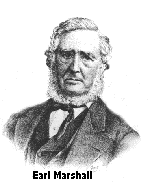 ngings
and boarded the ship “Brooklyn.” This vessel took the first group
of Mormon settlers from the east coast to California. The journey
took over six months as they sailed around Cape Horn to Hawaii, with
the final destination of San Francisco. ngings
and boarded the ship “Brooklyn.” This vessel took the first group
of Mormon settlers from the east coast to California. The journey
took over six months as they sailed around Cape Horn to Hawaii, with
the final destination of San Francisco.
After spending two years in San Francisco (then known as Yerba
Buena) the Marshall Family moved to
what is now Fremont’s Civic Center and Central Park area, at the
urging of John Horner. During the Gold Rush, Simeon and his uncle
went to find their fortune in the Sierra’s, but they soon realized that
Aunt Marshall made more “selling milk for a quarter a quart than
they did panning for gold.”
In 1850 Stivers finally settled down to the quiet life of dairy
farming. At the time of Simeon’s death in 1898, Simeon owned approximately
612 acres of land. This was one of the last intact open areas of
open land owned by a single family at the time of Fremont’s incorporation
in 1956.
THE HISTORY OF STIVERS LAGOON
The original lagoon was approximately 200 acres in size. The
area had an open lake as well as a fresh water marsh. As this
area became more populated this natural waterway was changed. Areas
of the original lake and marsh were filled causing the flow of water
to change to conform to the growing community.
Prior to the massive population boom in Fremont, the marsh
was probably deep enough for boating and swimming. In 1776 an explorer
described the lake as being “somewhat salty,” pointing to a possibility
of salt intrusion from the San Francisco Bay. It was described as
a green and flower-covered route to the bay waters.
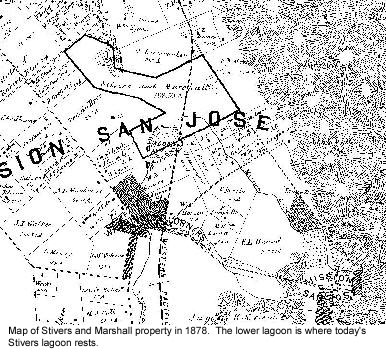 The marsh area at Stivers Lagoon was deeper in the late 1800's then it
is presently. The main tributaries included Mission Creek and Morrison
Creek, which drained from the hills. The groundwater table was much higher
than it is today, helping to maintain surface water all year. An
account by early settlers claimed that, “you could dig 15 feet down and
come up with a substantial well.”
The marsh area at Stivers Lagoon was deeper in the late 1800's then it
is presently. The main tributaries included Mission Creek and Morrison
Creek, which drained from the hills. The groundwater table was much higher
than it is today, helping to maintain surface water all year. An
account by early settlers claimed that, “you could dig 15 feet down and
come up with a substantial well.”
Tules that grew in the pond bordering the Stivers/Marshall property
were originally used by Native Americans to build boats, homes and
other essential items. Later in the 1860's they were harvested and
sold to local nurseries for packing their plants and trees for shipping.
The tule ponds which bordered the Stivers and Marshall’s property provided
an area for birds to feed and roost.
F. M. Smith, a contractor from Oakland, attempted to establish
a gun club in 1883 at the pond; unfortunately, there was not enough wildlife
for the members to hunt. Thus the club moved a few years later to
Coyote Hills. Sometime in the 1890's a levee was constructed to restrict
the amount of water flowing into the lagoon. As a result the marsh could
not maintain surface water, throughout the year. In the 1930's there
was a movement, initiated by land owners, to limit flooding of the area
caused by the natural watershed. This led to the channelization of Mission
Creek. At the same time Hetch Hetchy, a San Francisco water aqueduct
funded by the City of San Francisco, was being constructed through the
area; this caused further drying of the marsh.
In 1956, the year Fremont was incorporated, Simeon Stivers’ granddaughter
sold part of the undeveloped land to Alameda County Flood Control.
They in turn leased the land to the newly incorporated City of Fremont
for use as a nature area in Central Park.
|
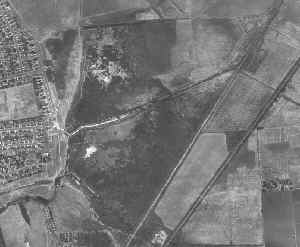
Aerial Photograph of the marsh and Central Park existing
in 1965
|
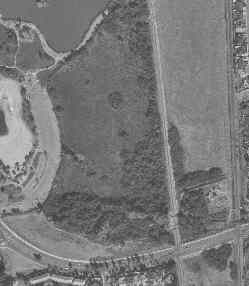
Aerial Photograph of Stivers lagoon in 1995
|
In 1960, Central Park included only 12 acres of land with a Community
Center. Today, the park area has grown to 450 acres which include:
a 40 acre nature area at Stivers Lagoon, a Swim Lagoon, four playground
areas, an 88 acre lake, sports complex, soccer fields, tennis courts, lawn
areas, and picnic areas.
The creation of Lake Elizabeth in 1968, caused the most damage
to the marsh at Stivers Lagoon. Mission Creek was rerouted
through the marsh which allowed the marsh to drain more rapidly and dry
during the summer. This allowed more upland plants and trees to grow
in the former marsh area.
In 1971 the park won an award for its beauty and design.
The Candlelighters donated $20,000 towards construction of the nature observation
boardwalk into the marsh area and the kiosk near the natural education
area. These two structures were built by both volunteer labor and
donations.
Unfortunately over the past twenty -five years the boardwalk
and the kiosk have fallen into disrepair due to a lack of maintenance
of this vital area. Currently the City of Fremont, in partnership
with the Math/Science Nucleus, is working to restore the wetlands at Stivers
Lagoon. The goal is to develop and provide an outdoor education program
and to reestablish the natural environment for future generations to enjoy.
STIVERS LAGOON TODAY
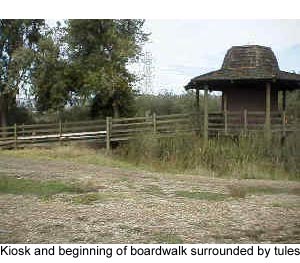 Stivers
Lagoon is part of the Laguna Creek Watershed, whose headwaters begin at
the elevation of 2500 feet and drop to sea level within 5 miles. This steep
decent is a result of uplifting caused by faulting. Ten creeks and drainage
channels flow into Laguna Creek, draining the hills and developed areas
of Mission San Jose, Irvington, and the Industrial Districts. Mission and
Morrison Creek join in the southern part of Lake Elizabeth to form Laguna
Creek. Laguna Creek is diverted at Stivers Lagoon into a high
flow (historic channel) and low flow (flood control channel) drainage
system (during storm events). Both channels then flow into Mud Slough in
southern San Francisco Bay. Stivers
Lagoon is part of the Laguna Creek Watershed, whose headwaters begin at
the elevation of 2500 feet and drop to sea level within 5 miles. This steep
decent is a result of uplifting caused by faulting. Ten creeks and drainage
channels flow into Laguna Creek, draining the hills and developed areas
of Mission San Jose, Irvington, and the Industrial Districts. Mission and
Morrison Creek join in the southern part of Lake Elizabeth to form Laguna
Creek. Laguna Creek is diverted at Stivers Lagoon into a high
flow (historic channel) and low flow (flood control channel) drainage
system (during storm events). Both channels then flow into Mud Slough in
southern San Francisco Bay.
Movement along the Hayward fault zone caused a depression
to form in this area. Since large reservoirs of ground water can
be found underneath (called the Niles Cone Aquifer), water easily percolates
upward in this area to cause a natural pooling of water that existed before
present day man-made Lake Elizabeth. Storm waters and springs along
the hillsides also bring water into this region.
The present day lagoon supports a variety of different habitats
spanning from Paseo Padre Parkway to the Southern Pacific Railroad to the
path of Mission Creek. The various environments including the marsh
are important in the preservation of a marsh habitat and provide a
refuge for numerous native species of plants and animals.
The maintained grassland has the largest number of non-native species
of plants including; wild oats, ripgut brome, soft chess, Mediterranean
and hare barley, mustard, fennel, poison hemlock, cocklebur, and yellow
star thistle. The animals of this area include small birds
and small mammals, especially rodents.
The most visible habitat is the riparian and forest environment.
This area contains numerous native plants, including: California black
walnut, Fremont cottonwood, arroyo and polished willow, California blackberry,
poison oak, sandbar willow, wooley sedge, baltic rush, pink smartweed,
and lippia. All of these plants have regenerated themselves in the
last 25 years. The animals in this area are mainly swallows,
warblers, towhees, sparrow species, finch species and various raptor birds.
|
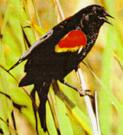
|
This is a sheltered area where they can forage, nest, and roost.
The current marsh area has remained relatively undisturbed and
is only accessible from the boardwalk. The dominant plant is the
native hardstem bullrush. Other native species are the; pink-flowered
knotweed, arroyo and polished willow, and western goldenrod. |
 |
|
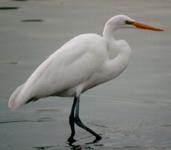
|
The wildlife found in this area includes great egret, great blue heron,
green - backed heron, marsh wren, common yellowthroat, American bittern,
red-winged blackbird, Western pond turtles, raccoons, foxes, muskrat, Virginia
opossum, striped skunk, and rodents such as deer mice. In dryer
areas, non-native plant species such as fuller’s teasel and bristly ox
tongue invade the landscape and inhibit the growth of native plants. |
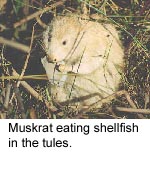 |
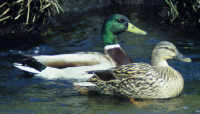 |
The Mission Creek ecosystem is an open water environment. The
plants are mainly aquatic and consist of duckweed, pondweed, cattails,
and tules.These plantshelp prevent erosion and an excess amount of silt
from entering the waterway.The wildlife in this area include the common
ducksfound around Lake Elizabeth as well as small fish and crayfish found
in the stream running through the lagoon. |
|
The entire lagoon and nature area are essential to our community.
It has been an excellent resource for school aged children to learn about
Fremont history as well 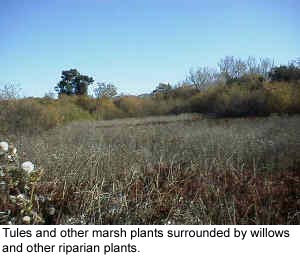 as
various habitats. Fremont Recreation Programs have included short
trips to the lagoon to go “crawdad fishing” and learn/experience the natural
habitats that exist in the area. This refuge is home to a wide variety
of different animals and plants that need this area to survive because
they cannot survive anywhere else so please treat this area with care and
respect! as
various habitats. Fremont Recreation Programs have included short
trips to the lagoon to go “crawdad fishing” and learn/experience the natural
habitats that exist in the area. This refuge is home to a wide variety
of different animals and plants that need this area to survive because
they cannot survive anywhere else so please treat this area with care and
respect!
REFERENCES
Earth Science Associates, 1993. Lake Elizabeth/Stivers Lagoon
Marsh Design and Improvement Program. EIR-92-56
400 pp
Thompson and West, 1878. New Historical Atlas of Alameda County.
170 pp
Wood, M. W., 1883. History of Alameda County, California.
1001 pp
Yee, Gilbert C., 1973. Central Park A Teacher’s Practical Guide
and Handbook to the Natural History of Stivers’ Lagoon. 80 pp
Hansen, Lorin K. and Bringhurst, Lila. 1996. Let this be
Zion. 280 pp
Sandoval, John S. 1965. The History of Washington Township. 190 pp
Credits:
Thanks to: Forest Frasieur, Barbara Silva, Kathy Cote, Mike Mullen,
and Sandee Strong |